Isolated in the middle of the southeastern Pacific Ocean nearly 2,340 miles from Santiago de Chile, 2,646 miles from Tahiti, 4,650 miles from Honolulu, and 4,245 miles from Los Angeles, Easter Island is one of the world’s most isolated spots. It is about 15,3 miles long and 7,6 miles wide and covers an area of 63,2 square miles. Terevaka at 1,663 feet is the highest point. This tiny triangular shape lost in the middle of the South Pacific Ocean is called “Rapa Nui” in the Pascuan language. The island is located at the southeastern most point of the Polynesian triangle. Like most Polynesian archipelagos, Easter Island was formed by volcanic eruptions at “hot spots” in the earth’s crust. The island consists of three extinct volcanoes, Maunga Terevaka, Rano Kau and Mount Poike. The large stone statutes or “Moaï” for which the island is famous were carved from volcanic rock. Easter Island’s landscape is littered with Moaï. Just like the pyramids of Giza, Angkor Wat or Machu Picchu, Easter Island is part of a long list of mysteries ! Many mysteries remain about the origins and way of life of the Rapa Nui civilization. While many secrets have been pried open by hard work, the island and its Moaï still give a hard time to ethnologists who seek to explain the mysterious and sudden disappearance of this people shortly before the discovery of the island, on Easter Sunday in 1722, by the Dutch navigator Jacob Roggeveen…
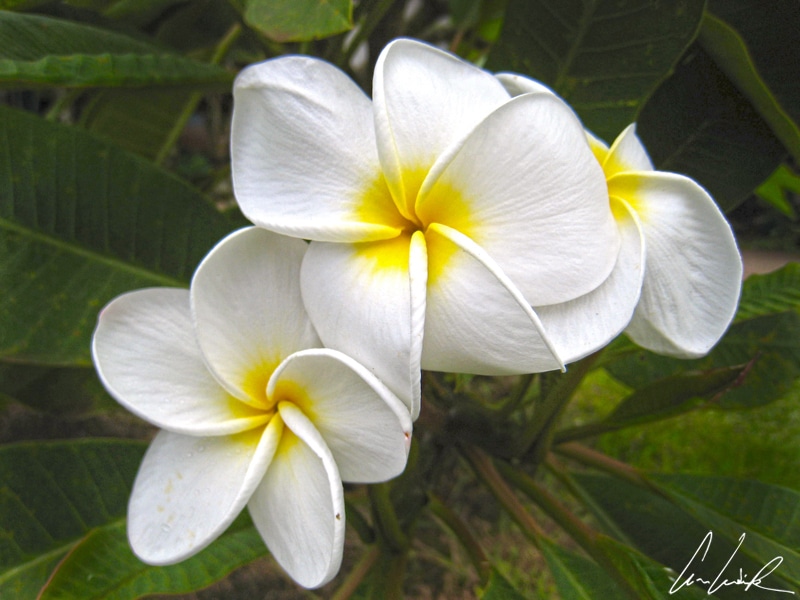
Frangipani fragrant flowers
On our little blue planet, they are plenty of islands… And yet “Rapa Nui” is an island that captivates any visitors… “Iorana (hello) Koho-mai (welcome), no hurry, relax ! Don’t you hear the music ? ». These slow rhythms, these sunlit melodies give us the tempo flavor of a past time. We are lulled by the throbbing movements of the waves, caressed by the warmth of the sun’s rays, and smell again and again the enchanting soft scents of fragrant flower leis of Frangipani, generic term Plumeria. Some species, both animal, and plant are endemic, but most are imported. All participate in the soft diversity of the island like this hibiscus with colorful flowers, this coral tree (Erythrin, Greek erythros which means “red”) with its velvety scarlet flowers, which are often compared to rooster crests and the dominant animal of the island that freely gallops or grazes here and there ! On the island, the vegetation consists mainly of grassy areas covering a vast network of underground cavities. There are some cultivated areas around the only village of Hanga-Roa, and, scattered here and there, eucalyptus woods. The coastline is more austere. The coast is mostly rocky and swept by the waves and wind. Only a few bays and sandy beaches interrupt this monotony as at Ovahe where we find a beautiful cove surrounded by volcanic cliffs. But let’s go back for a moment to our Frangipani flowers… This tree is considered a symbol of immortality (its cut stem can be preserved for a long time before being replanted !), and in local folk beliefs the Frangipani provides shelter to ghosts… a nice welcome gift, no ? Spirit of the island are you there? We are ready to walk with our leis across the island from North to South and from East to West to discover its mysteries !

The dominant animal of the island that freely gallops or grazes here and there !
A multitude of questions, starting with the origins of Rapa Nui, have long remained unanswered ? In the scientific community, two hypotheses existed for a long time… The first is that the inhabitant of Rapa Nui would have come from Polynesia. They would then be descendants of people who left Southeast Asia more than 8000 years ago. This slow but inexorable migratory wave would have reached first Polynesia and then Easter Island around the year 1000. The second possibility asserts the opposite that the Rapa Nui came from the East, from South America. They would then have left the Chilean or Peruvian coasts to reach Easter Island. Believing this second hypothesis, the Norwegian adventurer Thor Heyerdahl, like Ulysses, embarked in 1947 on an incredible “Odyssey”, seeking to prove that people of Polynesia had ancestral ties to the ancient Peruvians, and in the year 1000 crossed the Pacific from East to West ! Sailing on the “Kon Tiki” a 40-long log raft of balsa wood supposedly a replica of the rafts used by ancient Amerindian peoples, Heyerdahl and his five colleagues took sea on April 28, 1947. Many predicted certain death because these waters are not at all “Pacific“… Against all expectations, after 101 days the skiff reached an archipelago in the South Sea to the north of Easter Island. No matter, Thor Heyerdahl had shown that crossing the Pacific from East to West was possible. Eight years later he found on Easter Island irrefutable archeological evidence of South American ties such as a wall of perfectly nested stones and built without mortar (jointed architecture), reminiscent of some South American archaeological sites, especially Cuzco. So, was Easter Island colonized by people from America? Frankly “Kai ‘ite’ ana au” (I do not know)…

Anakena sandy beach
Elementary my dear Watson ! Two generations later, Thor’s theory took a blow when scientists demonstrated that the wall without mortar was not built during the Inca era, but 200 years later in the 17th century. “Thunder of Zeus” as Asterix would say, Thor was wrong, and the Rapa Nui would came from Polynesia ? Today, the question has been decided by genetic analysis… “The experts in Rapa Nui” have confirmed, after analyzing skeletons discovered in the south of the island that all the people had a genetic marker very clearly indicating Polynesian origin. But from where exactly since Polynesia has more than 1,000 islands ? Unfortunately, the precise origin could not be determined by genetics! So some mystery still hangs over the origin of the first inhabitants of Easter Island… Some scientists have discovered in the center of the island Nuku-Hiva in the Marquesas Archipelago, a stone platform encircled by statues so-called “Tiki”. There are some similarities between these and the Moaï on Easter Island. The “Tiki” have their hands on their belly and a protruding chin. If their size is tiny compared to Moaï, this can be explained by the stone available: a very hard basalt for the “Tiki” versus volcanic tuff for the Moai)… There is, therefore, a link between “Moaï” and “Tiki,” and the sculptors were probably part of the same ethnic group… There is also linguistic evidence. The Easter’s Island traditional language shares some similarities with Marquesan. But why did the first builders of Moaï leave the Marquesas Islands on catamarans to sail toward new lands ? Ah, curiosity and a willingness to explore is typical of the human race, isn’t it ? Thus the first king of the Rapa Nui, Hotu Matu’a, would probably have landed mear the village of Anakena on northeastern Easter Island, the only place with a sandy beach suitable for canoes.

The Ahu Tongariki and its horses
Anakena is not only a paradisiacal sandy beach; it is also the birthplace of the history and culture of Easter Island where the oldest artifacts, dating from about 1200 AD were found… The Ahu Nau Nau and its five Moïa ”Pukao” stand out in silent rows between coconut trees, the sandy beach, and turquoise waters. The statues are crowned with a “Pukao” (headdress or chignon,) a large volcanic slag hat with which the Rapa Nui adorned the heads of some Moaï. Nice headwear, very fashionable at the time! These “Pukao” are made from reddish volcanic scoria from the quarry of Puna Pau, not far from Hanga Roa. At Puna Pau we meet “The Mad Hatter” of the island and the origin of these incredible hats ? From a height of about three to seven feet and a diameter of six to ten feet, these cylinders weigh between nine and twelve tons. In 1872, the French novelist Pierre Loti (1872) wrote, “Leurs coiffures qui étaient des espèces de turbans, en une lave différente et d’un rouge de sanguine, ont roulé çà et là, aux instants des chutes, et l’on dirait de monstrueuses pierres meulières “ (Their headdresses, turbans in a different lava and blood red in color, are rolled here and there and look ready to fall off, like monstrous millstones.) The reddish color, typical of hematite, is intense in the Moaï. Indeed, at the beginning of the 20th century, scientists discovered a Moaï with traces of red pigment. The massive stone had been painted with red and white patterns, the sacred colors of the island. Close your eyes and imagine these colorful behemoths scattered around Easter Island! Out of the 887 Moaï counted to date, some of them stand on platforms (“Ahu”) called Ahu Tahai, Ahu Akivi or Ahu Tongariki. In front of such a display, we are torn between the magic of the place and the desire to know more, even too much…
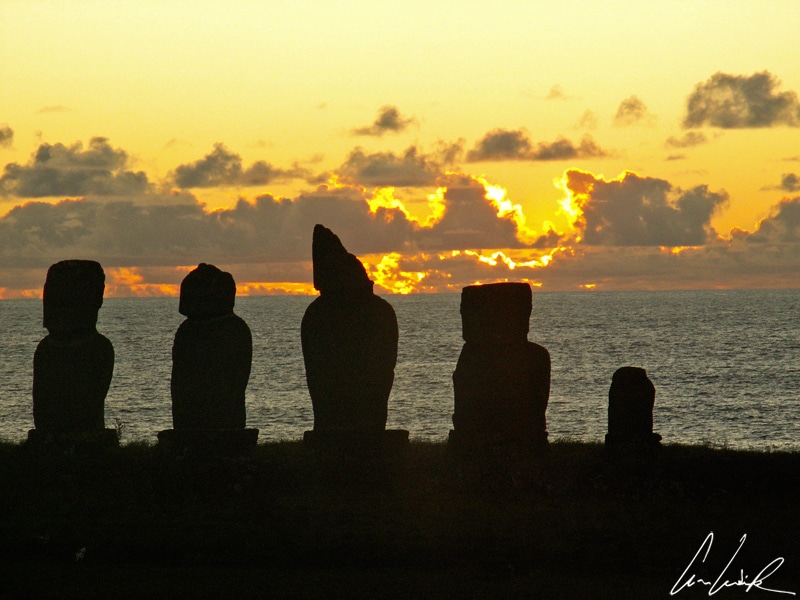
At nightfall magic surrounds the Ahu Vai Uri
The waves break along the jagged coastline and a few steps away unreal statues seem to have sprung up from the ocean to freeze on the island. They are lined up, with their back to the fury of the ocean, like frozen soldiers standing at attention. An emaciated torso and haughty face, they seem to challenge the visitors fascinated by their enigma. Once upon a time, in all villages, about 30 feet from the houses stood what is called an “Ahu Moaï“. The structure always the same: a stone platform on which the natives placed stones that allowed a Moaï to be erected. The imposing Ahu Tongariki, the most significant group of Moaï on the island, consists of fifteen majestic statues standing as a symbol of protection with the Pacific Ocean at their back. Their name refers to the east wind. The fifteen Moaï stand on a 328-feet long central platform facing the rising sun of the Summer solstice. According to tradition, the Moaï could project the mystic power of the ancestors called mana or a spiritual power to protect the village and its inhabitants. Therefore all Moaï look toward the interior of the island. Ahu Tongariki is located on the far southeastern end of the island at the foot of the Rano Raraku (the Moaï quarry). In 1960, a major earthquake took place on the Chilean coast about 2,300 miles away from the Ahu Tongariki producing a disastrous tsunami. The tidal wave hit the stone statues with its full force, pushing them several feet away from their origin location. They were restored by a Japanese benefactor, and were soon back on their feet. As twilight approaches, only horses observe a few insolent birds taunting these giants by leaving certain indelicate traces on their heads or on volcanic tuff, indelicate traces… No matter, at nightfall magic surrounds the Ahu Vai Uri with the five aligned Moaï turning their backs to the immensity of the ocean. Later, as the stars dot the sky and the moon shines down upon a darkened ocean, the Moaï spirits gather night after night in the heart of Easter Island for a big feast and chat about the world…
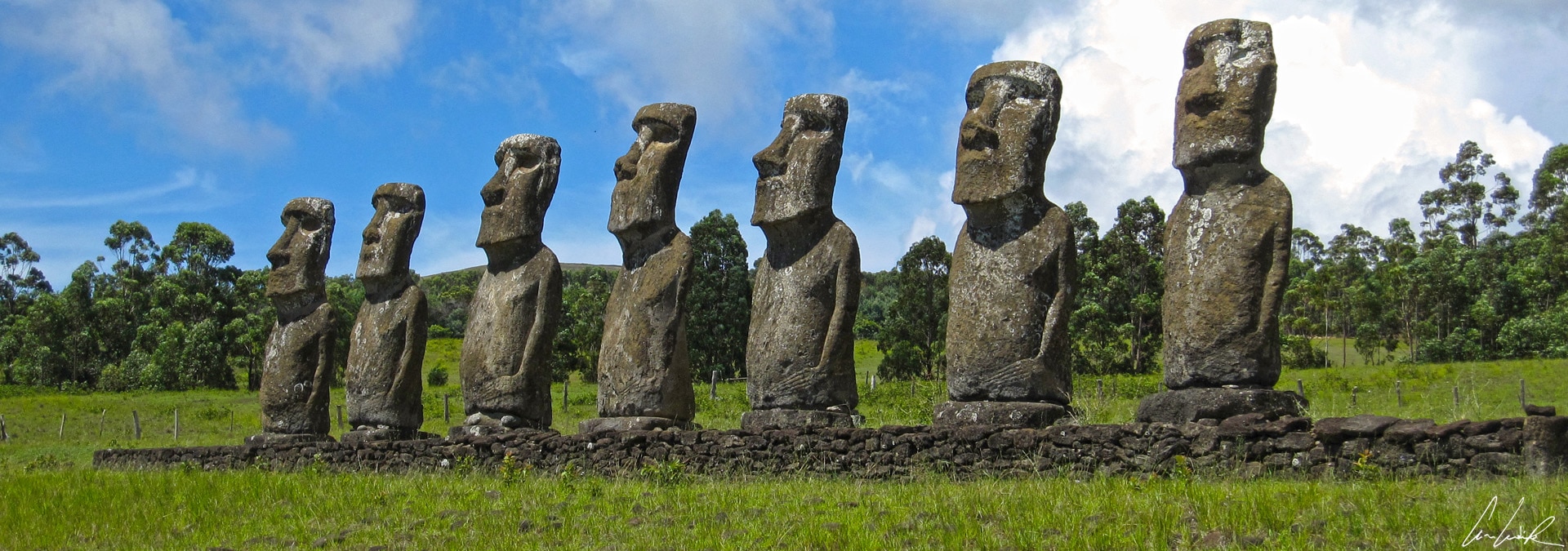
The Ahu Akivi with his seven Moaï aligned in front of the ocean
The people who lived in front of the Moaï could establish a bond, a communion with their ancestors. The Moaï represent the spirits of ancestors who went out to sea. The ancestors look at the villages and converse with their descendants. Besides, these statues have hollow eyes filled with coral. These coral eyes allow the Moaï to monitor better and to protect the living. Only the sublime Ahu Akivi with his seven Moaï aligned in front of the ocean breaks with tradition. Still visible today, the seven explorers of Ahu Akivi, are the only Ahu on the island built on land and not on the shore. They are the only Moaï that look at the ocean; all the others turn their back to the ocean. They may represent the seven explorers who were once sent to explore new lands before the colonization by King Hotu Matu’a. With their gaze fixed on the ocean, symbolically towards their native Polynesian island, they face their roots, these remote islands from which they originated…

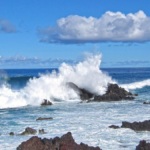



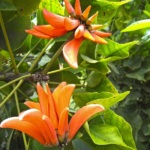
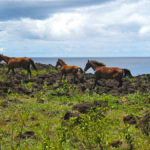


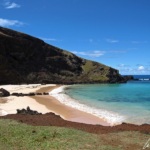
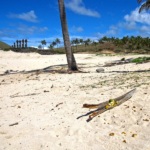
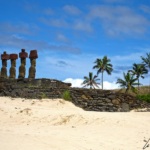


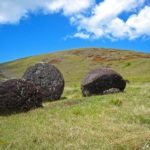
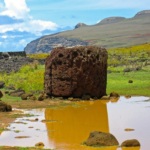

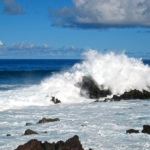
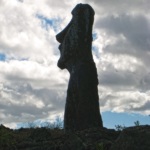

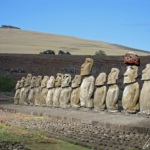

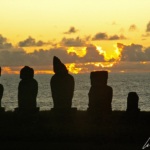
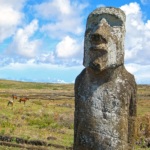

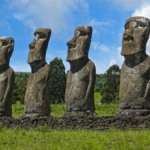



I’ve always wanted to go to Easter Island. It looks incredible and with so much history (and mystery)! Bad pun, but your photos are gorgeous.
Thank you 🙂 When it comes to ancient mysteries, there are few as fascinating as the one surrounding Easter Island !
Wow, I had no idea there were so many wild horses on the island. Fascinating! I hope to get there someday!
With it’s unbelievably Moaï and breathtaking natural allures, Easter island should definitely be on your bucket list. If it’s not, it soon will be… 😉
I have always wanted to visit Easter Island – to see the heads and understand more about such an interesting place. I would love to see the wild horses or ponies and I think the flora while you were there was insane!! Thank you for sharing!
From wild horses that roam the island to massive Moaï standing tall, remote Easter Island has a fascinating past 🙂
Easter Island is at the top of my bucket list. Thank you for such a thorough review. And your pictures are AMAZING! I can’t wait to check out the island.
Easter Island is worth the trip, it is a unique location with its own unique culture, the Moai statues are truly iconic and give us an insight into the workings and philosophy of a past civilisation 😉
I am so jealous you have been to Easter Island! I have serious island envy and wanderlust. I have been to Tahiti and am so fascinated by all things Polynesian. I know now with DNA analysis they can do some cool things – I want to do one of those home kits too! Anyway, how did you get there? Fly? And from where?
One of the most mystifying places on the planet ! It should be on your bucket list 🙂 Because of its remote and isolated location, the most common way to get to Easter Island is by plane. Currently Lan (Latam Airlines) is the only airline that has scheduled flights to Rapa Nui. It connects the island with from the Airport Arturo Merino Benítez in Santiago de Chile. This the most important and accessible point of connection. The duration of the flight from Santiago de Chile to Easter Island is about 5 hours and 40 minutes.
Woah so cool!!:D Planning a trip to Chile for September and would love to visit the Easter Islands! Your photos capture the beauty of the places so well…Such gorgeous sunsets! Thanks for sharing a little glimpse of this magical destination.
Easter Island is definitively a must visit if you’re heading to Chile ! It’s really amazing to take a stroll on Easter Island and take in the beauty and grandeur of the Moaï 😉
Easter Island is one these places I dream of going but don’t give myself the means to. I’m fascinated by its mysteries and legends. I gather that there aren’t many coconut trees there but the land is stimulating enough to make you forget about that. 🙂
Easter Island is definitively an island with a fascinating Polynesian history, impressive monuments, and much natural beauty to speak of ! As one of the most mystifying places on the planet, you can discover much about our species through what was left behind here 🙂
Your photographs are gorgeous and can make anyone visit Easter Island. Horses are galloping freely on the island, I never saw anything like this before. The statues give a different dimension to this place.
Thank you 🙂 The horses roam freely and are semi-wild. Easter Island is actually home to more horses than humans 😉 Few areas in the world possess a more mystical pull than this tiny speck of land ! This island is truly a magical & an interesting place to visit.
Love this post. Rapanui Easter Island looks magical. It is definitely on our list. How amazing are the Moai! Love you photos – you really capture everything so beautifully.
It was quite emotional standing in front of the Moaï for the first time and really realizing where on earth I was standing. A dream to be there and see these Moaï only feet away 🙂
I am so a big fan of this kind of post. Thanks a lot! It’s so interesting! 🙂
Thank you 🙂 Easter Island fascinates me with his seeming contradictions !
I love how we still don’t and probably never will have all the answers to history. Some things are just better left as a mystery 🙂 I do so want to get to Easter Island and your photos just make that desire so much more. Beautiful shots and love all the history of it and the descriptive sounds and sights of the flowers including the frangipani. The smell of them is just fantastic.
I always knew that I wanted to visit Easter Island. I mean, who wouldn’t want to visit this mysterious tiny island in the middle of nowhere? For scientists and anthropologists, so many questions remain about how and why these iconic stone heads were created and erected all around this tiny island. I came ready to exalt a magical place that’s completely cut off from the rest of the world. But while its past may remain shrouded in mystery, Rapa Nui is very much a real place, alive and changing 🙂